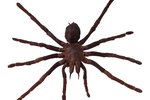
Costa Rica's dense vegetation and warm, tropical climate make it a haven for creepy-crawly insects. Of the 4,000 known varieties of insects in Costa Rica, most are only an annoyance to humans. A few of Costa Rica's spiders, though, are venomous and warrant strict avoidance.
An Eight-Legged Medical Breakthrough
In 2010, the Brazilian wandering spider was listed in the Guinness Book of World Records as the world's most venomous spider. He has meandered into most of Central America, including Costa Rica. Known as the banana spider, he has a propensity to stow away aboard banana ships headed for the United States. This fast, aggressive spider does not remain in a web but prefers to wander forest floors. In addition to the great outdoors, he will hide inside shoes, hats and other clothes. This spider's venom is a powerful neurotoxin that normally causes tremendous pain and even death. One interesting side effect of the Brazilian wandering spider's bite, is it causes long-lasting erections in male bite victims. Scientists have identified a peptide in the spider's venom that causes this strange effect, and hope to use it to create a better erectile dysfunction medication for men.
The Spousal Slayer
A fairly common spider throughout the Americas, the female black widow is easily recognized by her shiny, round, jet black body and trademark red hourglass on her underbelly. Her venom is said to be 15 times stronger than that of a rattlesnake, but she is generally shy and only bites when disturbed. While uncomfortable, black widow bites are rarely fatal to humans. Symptoms include muscle aches, sweating and nausea, headache and abdominal cramping. Pain around the bite site may last 8 to 12 hours, while other symptoms can last several days.
The African Immigrant
Brown widow spiders, believed to have originated in Africa, are common throughout the Americas and are easy to locate in Costa Rica. They dwell in webs around homes and buildings, or in wooded areas. Smaller and lighter than the black widow spider, the venom of the brown widow is twice as strong, but she injects less venom per bite. The female brown widow also has the telltale hourglass marking on her belly, but hers will be orange or yellow in color. Prolific breeders, the brown widow is capable of supplanting the black widow in shared habitats.
Scorpions
Fourteen species of scorpions reside in Costa Rica. They range is size from small to large, and every color from brown to red to bright yellow. The Centruroides bicolor prefers forested areas along the Pacific Coast and will wander into human dwellings. He is one of the brighter scorpions, with a yellow body and black pincers and tail.
References
Photo Credits
-
Zedcor Wholly Owned/PhotoObjects.net/Getty Images



